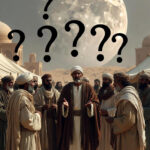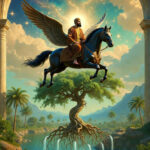One of the most striking historical blunders in the Qur’an is its portrayal of Dhul-Qarnayn (“The Two-Horned One”) in Surah al-Kahf (18:83-101). Islamic tradition identifies this mysterious figure as none other than Alexander the Great — the Macedonian conqueror who lived in the 4th century BCE. But the Qur’an depicts him not as a Greek pagan steeped in Hellenistic polytheism, but as a righteous monotheist who traveled the world spreading divine justice.
This confusion did not arise in a vacuum. Muslim historians and commentators openly admitted that Dhul-Qarnayn was Alexander, exposing how Muhammad absorbed legendary tales about Alexander and mistook them for divine revelation.
Qur’an 18:83 and Tafsir al-Jalalayn
The Qur’an introduces Dhul-Qarnayn when the Jews allegedly challenged Muhammad with questions to test his prophethood:
“And they ask you about Dhul-Qarnayn. Say: I shall recite to you an account of him.” (Qur’an 18:83)
Classical exegesis leaves no doubt about his identity. Tafsir al-Jalalayn explicitly names him:
“And they [the Jews] question you concerning Dhū’l-Qarnayn whose name was Alexander; he was not a prophet.” (Tafsir al-Jalalayn, on Qur’an 18:83)
Here we see the blunt admission — Dhul-Qarnayn was Alexander the Great. Yet the Qur’an elevates him as a God-guided ruler, blurring the line between a pagan general and a proto-Muslim servant of Allah.
Al-Tabari: Alexander as One of the Four Kings Who Ruled the World
The great early historian Al-Tabari (9th–10th century) confirms this identification in his monumental history. In Vol. 2, page 109, Tabari cites traditions that:
“There were four kings who ruled the whole world, two unbelievers and two believers. The unbelievers were Nimrod and Nebuchadnezzar, while the believers were Solomon, David, and Alexander.”
According to this account, Alexander is grouped alongside biblical prophets as a believing king, despite the fact that historical Alexander worshiped Zeus, Ammon, and various Greek gods, and claimed divine status himself. This is a clear rewriting of history to fit Islamic narratives.
Al-Tabari Vol. 5: Alexander as “The Man with the Two Horns”
Later, in Al-Tabari Vol. 5, pages 173-174, the historian expands:
“Dhu al-Qarnayn before me submitted himself [to God], a king to whom the other kings became humble… ‘The man with the two horns’ of Qur’an XVIII (18:82-97/83-97) generally identified in Muslim lore with Alexander the Great.”
Here Alexander is explicitly equated with Dhul-Qarnayn, the Qur’anic figure praised for traveling to the ends of the earth, building a massive barrier against Gog and Magog, and ruling with justice.
The irony is staggering: the Qur’an takes the legendary, mythical tales of Alexander (popular in Late Antiquity through the Alexander Romance) and re-packages them as revelation.
The Legendary Journeys of Dhul-Qarnayn
The Qur’an further describes Dhul-Qarnayn traveling to the far west and east:
-
At sunset, he saw the sun “setting in a pool of black, murky water” (Qur’an 18:86).
-
At sunrise, he encountered people “for whom We had made no shelter against the sun” (Qur’an 18:90).
-
He built a mighty iron and copper wall to protect people from Gog and Magog (Qur’an 18:93-98).
Al-Tabari and other commentators narrate these events as literal deeds of Alexander. For example, Tabari records:
“He witnessed the setting of the sun in its resting place into a pool of black and foetid slime.” (Al-Tabari Vol. 5, page 174)
Clearly, this is myth, not history. Alexander never built a wall of iron, nor did he see the sun sink into a muddy swamp. These details come straight from the Alexander Romance — a collection of legends circulating among Jews, Christians, and pagans in Late Antiquity.
Why This Is a Problem for the Qur’an
The identification of Dhul-Qarnayn with Alexander the Great exposes several serious flaws:
-
Historical Inaccuracy – Alexander was a polytheist who demanded worship as the son of Zeus. To present him as a monotheist servant of Allah is a gross distortion.
-
Borrowing from Legends – The Qur’an’s tales of Dhul-Qarnayn derive not from divine revelation, but from the popular Alexander Romance — fictional stories known in Muhammad’s time.
-
Contradiction of Islamic Claims – Muslims insist the Qur’an is “perfectly preserved” and free from error. Yet here it misrepresents a well-known pagan king as a God-fearing believer.
-
Theological Absurdity – If Alexander was truly a Muslim ruler guided by Allah, why is there no trace of Islam in his empire? Instead, he spread Hellenistic culture, idolatry, and ruler-worship.
Conclusion
By identifying Dhul-Qarnayn as Alexander the Great, the Qur’an commits a fatal historical mistake. It confuses a pagan conqueror with a righteous servant of God, borrowing legendary material from the Alexander Romance and passing it off as revelation.
Even classical Muslim authorities like Tafsir al-Jalalayn and Al-Tabari admit the identification. This is not a claim by modern critics — it is preserved in Islam’s own most trusted texts.
For Muslims who believe the Qur’an to be flawless and divinely inspired, this presents a disturbing dilemma: either accept that the Qur’an endorsed a pagan idolater as a believer, or acknowledge that the Qur’an contains human errors drawn from myths, not from God.






